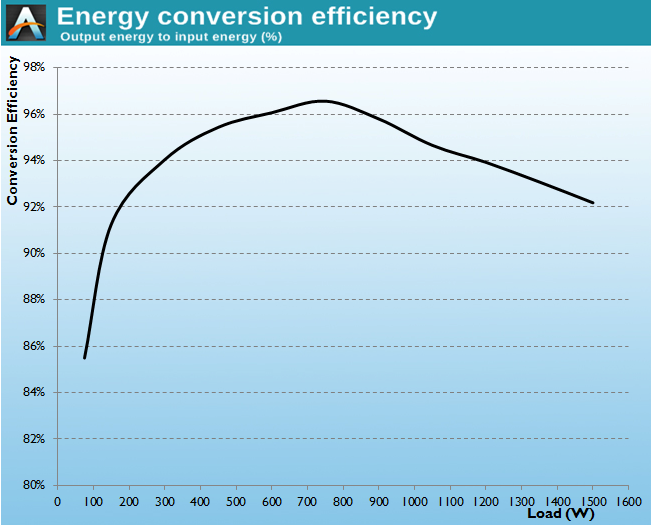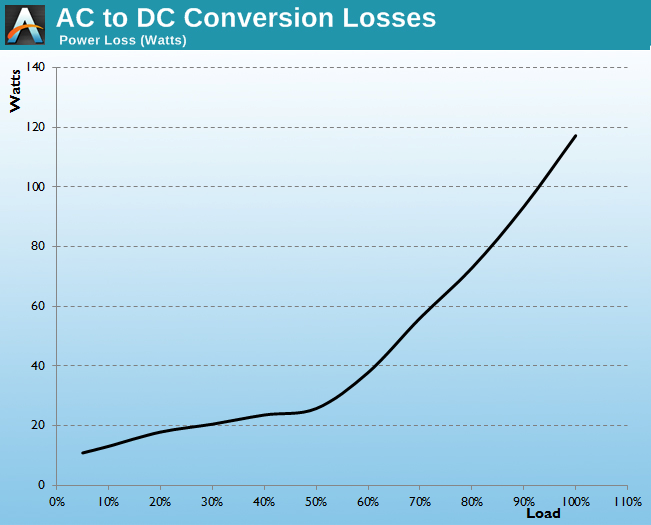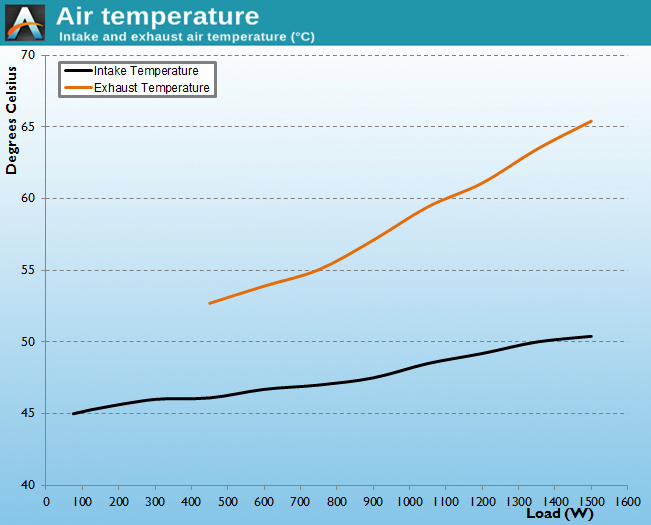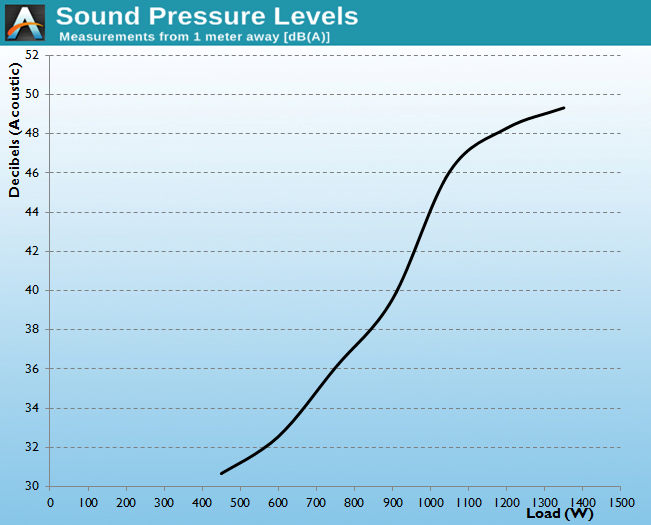Corsair AX1500i Power Supply Review
by E. Fylladitakis on September 11, 2014 5:00 AM EST- Posted in
- Cases/Cooling/PSUs
- Corsair
- PSUs
- 1500W
Hot Test Results
From the tables below, we can see that the output power quality of the Corsair AX1500i is simply setting new performance records. Our instrumentation recorded a maximum ripple of just 16mV on the 12V line under maximum load, while drawing 107.2 Amperes from it! Cross loading the voltage lines had virtually zero effect on the stability of the unit, courtesy of the dual LLC PSU design we mentioned in the Internal Design section. Finally, the voltage regulation is remarkable, with the worst and best results being 0.5% and a mere 0.15% on the 5V and 12V lines, respectively!
| Main Output | ||||||||
| Load (Watts) | 300.98 W | 751.78 W | 1126.37 W | 1501.55 W | ||||
| Load (Percent) | 20.07% | 50.12% | 75.09% | 100.1% | ||||
| Line | Amperes | Volts | Amperes | Volts | Amperes | Volts | Amperes | Volts |
| 3.3 V | 5.15 | 3.34 | 12.86 | 3.34 | 19.3 | 3.33 | 25.73 | 3.33 |
| 5 V | 5.15 | 5.02 | 12.86 | 5.02 | 19.3 | 5 | 25.73 | 4.99 |
| 12 V | 21.44 | 12.03 | 53.6 | 12.02 | 80.4 | 12.01 | 107.2 | 12.01 |
| Line |
Regulation (20% to 100% load) |
Voltage Ripple (mV) | |||||
| 20% Load | 50% Load | 75% Load | 100% Load |
CL1 12V |
CL2 3.3V + 5V |
||
| 3.3V | 0.4% | 6 | 10 | 12 | 12 | 4 | 8 |
| 5V | 0.5% | 4 | 6 | 10 | 12 | 6 | 10 |
| 12V | 0.15% | 6 | 8 | 12 | 16 | 14 | 6 |
High ambient temperature have a miniscule impact on the energy conversion efficiency of the Corsair AX1500i, reducing the average nominal load (20-100%) efficiency down to 94.6% and the maximum efficiency of the PSU to 96.5%. The overall efficiency drop is a mere 0.3% percent over a temperature rise of 25°C, which is simply amazing, displaying both the effectiveness of the design and the quality of the active components. As such, the conversion losses remained nearly unaffected despite the much higher ambient temperature.
Overall, the behavior of the cooling system inside our hot box was similar to our "cool" testing results, with the sole exception being that the fan turns on at a much lower load than before. It also gets noticeably louder, but considering the massive power output, the AX1500i did not get hot at all, suggesting that the thermal control circuit is programmed to maintain low operating temperatures under any circumstance. We would be hard-pressed to find such low temperature readings even in reviews of units with half the capacity of the AX1500i.















55 Comments
View All Comments
pleuph - Thursday, September 11, 2014 - link
Come back when you've got a 1.21GW model.davidgirgis - Thursday, September 11, 2014 - link
1.21 GW? 1.21 GW. Great Scott!How could I have been so careless? 1.21 GW, Tom? How am I gonna generate that kind of power? It can't be done, can it?
Marty, I'm sorry, but the only power source capable of generating 1.21 gigawatts of electricity is a bolt of lightning.
A bolt of lightning, unfortunately, you never know when or where it's ever gonna strike.
xerandin - Monday, September 15, 2014 - link
We do now.Dadunn1700 - Wednesday, October 21, 2015 - link
Lol. I'm sure he will Doc when the time machine is finished. ; )DanNeely - Thursday, September 11, 2014 - link
The use of a C19 cable instead of C13 is required to comply with IEC 60320. C13 is limited to 10A of current, or 1100/1200W of input power. C19 bumps the max to 16A.http://en.wikipedia.org/wiki/IEC_60320#Appliance_c...
mapesdhs - Thursday, September 11, 2014 - link
Heh, 16A... the perils of 110V. ;)Kinda expensive. I just keep hunting for used Toughpower 1475W XT units, saved more
than $1500 so far.
Ian.
JayTheKing - Saturday, September 13, 2014 - link
This would be a problem for New Zealand power points, as our max current draw is 10A @ 230/240. Only power point in our house that allows for more than 10A is the oven and hot water cylinder.DIYEyal - Monday, September 15, 2014 - link
Because you're at a higher voltage. You won't have a problem. 10A in 230v means 2300W. That power supply will draw maximum of 7 amps from the wall (1500W at 92% efficiency means 1620w from the wall, at 230v it means 7 amps)Galatian - Thursday, September 11, 2014 - link
I purchased this power supply over two months ago. It is superb, but those cables are awfully stiff!Chrispy_ - Thursday, September 11, 2014 - link
Article starts with "making an 80+ PSU is much cheaper and easier than it used to be" and then here's Corsair with their ridiculous $450 PSU for the 0.01% of people who incorrectly believe they actually need this much power.Halo product, useless for almost everyone.